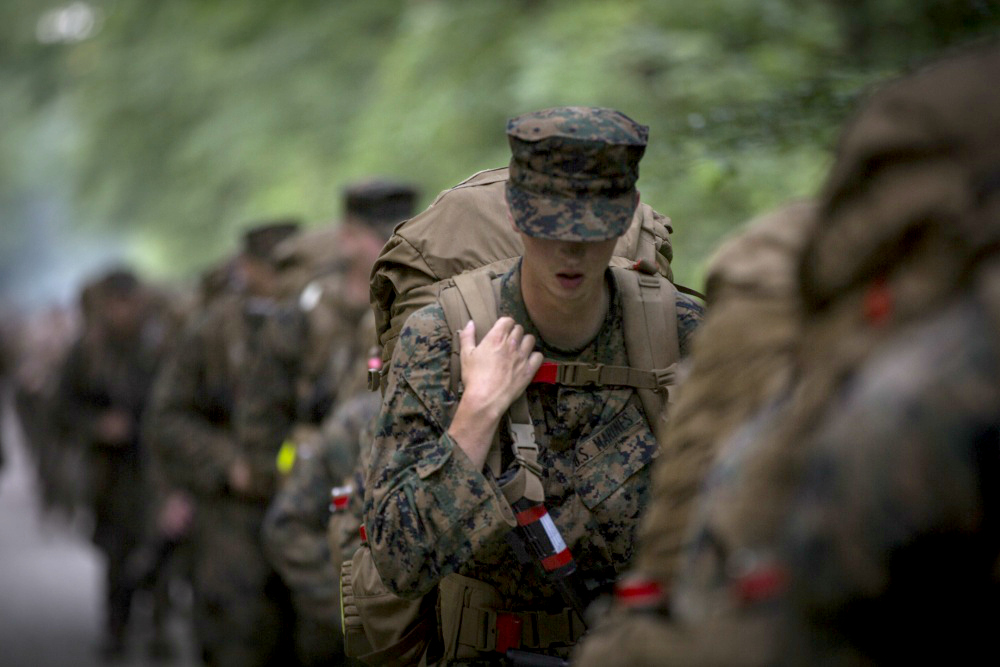
From Naval Health Research Center Public Affairs
How fast can you run 50 yards? Now, add an 80 pound backpack. Can you run the same distance as fast as you did without the heavy load?
If you’re a warfighter, running across open ground in battle, adding just one second to your time can be the difference between life and death.
Aside from matters of life and death, the long-term impact of carrying heavy loads may cause wear and tear on bones and muscles, potentially leading to acute and chronic injuries. Finding ways to lighten the load that modern warfighters carry is important to survivability and injury prevention. But doing it right and making sure service members have all the protection and gear they need for their mission while also being able to perform operational tasks is crucial. That’s where science and research come in.
For the past several years, Karen Kelly, Ph.D., a research physiologist at the Naval Health Research Center (NHRC), has studied the effects of load carriage on mobility, performance, and injury trends in Marines. Her research assesses the relationship between the weight of the loads carried by service members, potential injury, and operational performance.
“Modern warfare requires warfighters to carry large, physical loads into the operational environment to accomplish their mission,” said Kelly. “Body armor has become a necessity in military operations. Unfortunately, it usually consists of several heavy protective plates. And, in addition to body armor, military personnel typically carry essential gear, food, and water, all of which add to the load. Based on self-report surveys, infantry Marines carry, on average, over 85 pounds of mission essential equipment in their combat loads.”
Kelly’s recent studies investigated how different load carriage weights affect the spine and a warfighter’s ability to perform specific operational tasks. Additional research focused on testing and evaluating personal protective equipment (PPE) prototypes to assess their impact on gait, balance, marksmanship, potential for musculoskeletal injury, and subjective feedback such as comfort and perceived exertion.
“Finding the right balance between weight, function, and protection is a challenge,” said Kelly. “Conducting comprehensive testing and evaluation on new equipment and studying how different aspects of load carriage impact warfighter physiology are crucial to minimizing injuries and optimizing performance.”
From the field to the lab, Kelly and her team are doing the research to provide a scientific basis for helping find that balance.
One of Kelly’s first studies to address the issue of load carriage in terms of injury potential and performance was conducted with Marines relatively new to the military, having served for less than a year. The study was designed to determine how heavy loads affected the compression of intervertebral discs, movement of the spine, and the ability to perform operational tasks.
Kelly and her team, in collaboration with staff from the orthopedics department at the University of California San Diego, analyzed the spines of the Marines who participated in the study using magnetic resonance imaging while they wore varying weights and assumed different positions, just as they would in the field, sitting, standing, and prone on their elbows. Kelly found that loads greater than 30 percent of an individual’s body weight decreased both performance and marksmanship.
Kelly and her team evaluated the physiological and biomechanical effects of prototype equipment in both a controlled laboratory setting and a field environment to assess the new gear and compare it to legacy equipment. NHRC’s strategic location in San Diego and unique research capabilities makes it the ideal lab for conducting this type of research. Among the many land, air, sea, and special operations units in the region, Marine Corps Base Camp Pendleton is just over an hour from NHRC, providing NHRC researchers with access to numerous infantry units.
“Evaluating prototype equipment while warfighters wear the gear and perform operational tasks in both a controlled lab environment and out in the field allows us to better assess that gear’s impact on performance and potential for injury,” said Kelly.
To do this, Kelly collaborated with fellow NHRC scientist and biomedical engineer, Pinata Sessoms, Ph.D., to leverage the research capabilities of the Computer Assisted Rehabilitation Environment (CAREN), an immersive virtual reality system in NHRC’s Warfighter Performance Lab. Sessoms and her team used the CAREN to measure reaction time, head and eye movement, balance behavior, and muscle activation in relation to the prototype gear.
In the field, Kelly and her team analyzed muscle activation, walking speed, spine kinematics (the movement of the spine), range of motion, and cognitive function as well as more subjective data such as how the Marines wearing the gear perceived levels of comfort and exertion during operational tasks.
Researchers then analyzed the data gathered from the lab and field to develop a comprehensive comparison of the prototype equipment against existing PPE.
“The work we do, the whole point of our research, is to improve the operational readiness of our warfighters,” said Kelly. “By using scientific methods to assess how mission essential equipment impacts the musculoskeletal system, optimal performance, and survivability, we are putting vital and validated knowledge into the hands of decision-makers to help them optimize the balance between carriage load and survivability, health, and performance.”
 Navy Medicine World Class Care… Anytime, Anywhere
Navy Medicine World Class Care… Anytime, Anywhere






Re Combat Load
Realizing the load is only part of the equation. The other side is the human being (injuries are high, nutrition may be poor, bone status may be poor, etc.)….. and other equipment like boots.
Re Combat Load